
Health and safety should be something that is the bedrock of all businesses. If your company does not take its commitments to the health and safety of its employees, visitors, and customers seriously, then you should really start to do so.
Accidents can happen often, and in no way would you want your business to ever be the reason that someone gets injured in any way, or worse.
In the worst-case scenarios, where a company is negligent in its management of the health and safety of its employees, customers, or visitors, then the directors themselves could personally face hefty fines or even face criminal charges.
With this in mind, your business needs a good health and safety strategy. This should cover everything from assessing the risks through to training employees on safe working practices.
In this article, we’ll take a look at how you can manage your health and safety strategy.
Carry Out Risk Assessments
The first stage in any health and safety strategy should be the risk assessment. A risk assessment should be carried out for every aspect or area of the business. Assessing the risks within your workplace is essential for both the health and safety of anyone who enters.
If you are not regularly reviewing every aspect of your premises and the way that you are working within it, then you are setting yourself up for an accident as well as a potential lawsuit.
You will need to go through every area of your companies buildings and external areas and look for anything that could pose a potential risk to someone. Following this, you will need to come up with a way of dealing with this risk. For instance, you may have loose shelving that could potentially fall over and hurt someone if it is overloaded.
To minize the risk you should ensure that the shelving is clamped into place. There should be a maximum load which the shelves should hold, and you should consider safe handling of the items that are on the shelves. The more measures and practices that you can put in place to minimize accidents, the better.
Another example would be that if you have items stored on the floor in a stockroom, there is a chance that they may obstruct a fire route. They could also become a trip hazard. Marking areas where it is unsafe to store items will be essential.
You can carry out risk assessments in every area of your business, on the use of every item of equipment, and you can carry out risk assessments on groups of employees too. For example, you may have a risk assessment carried out on pregnant or young workers- this may recommend tasks which should not be completed by certain groups of employees.
You may also carry out a risk assessment on the use of computer equipment. This might recommend using ergonomic office chairs for bad backs, or paying attention to the brightness of the screen to avoid squinting or headaches.
Test Your Fire Equipment
Your workplace must have a fire alarm installed. You should test that this is working on a regular basis- ideally at least every week. If you have multiple break glass points, check them all in a rotation. Record the findings from all of your tests as you may get inspected by your local authorities or the fire service.
You should also ensure that all of your emergency lighting is working too and replace all dead light bulbs as required.
If your building has smoke detectors sprinklers, and fire extinguishers, then you should have a qualified engineer out to test these on a regular basis.
Create A Training Program
Knowing exactly what to do in the event of a fire is vital for the safety of your team. By not sharing this information with each and every employee that will be working with you on the first day of their employment, you are putting their lives at risk.
All of your employees should know how to escape from the building in the event of a fire, they should also know where they need to go as well as how to sound the alarm.
In addition to fire safety, you will need to make sure that you train all of your employees on every aspect of health and safety that is applicable to their role. This may include manual handling, the use of knives, lone working, using chemicals, how to use a stepladder safely and much more.